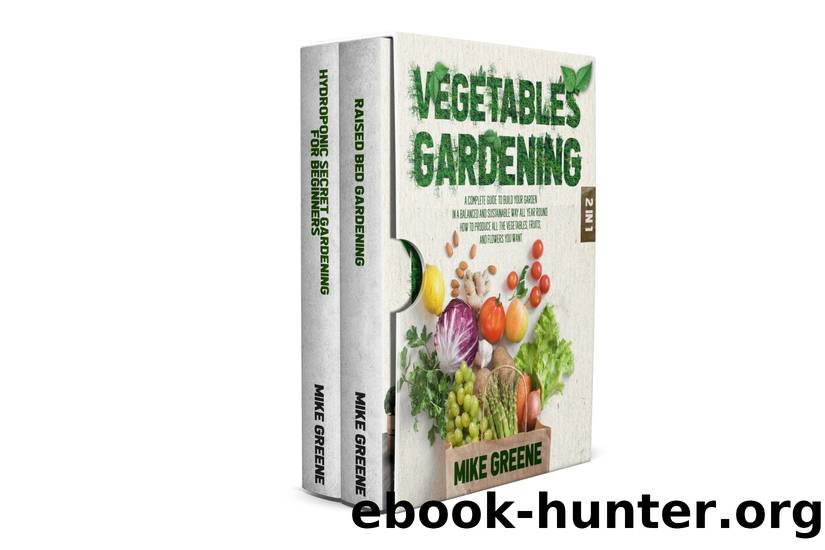VEGETABLES GARDENING: A COMPLETE GUIDE TO BUILD YOUR GARDEN IN A BALANCED AND SUSTAINABLE WAY ALL YEAR ROUND. HOW TO PRODUCE ALL THE VEGETABLES , FRUITS, AND FLOWERS YOU WANT by MIKE GREENE

Author:MIKE GREENE [GREENE, MIKE]
Language: eng
Format: azw3, epub
Published: 2020-12-27T16:00:00+00:00
Conclusion
The above discussion brings us to the conclusion that Hydroponics is a method to grow plants and food with the help of water. In this method, all the necessary elements for the growth of plants are provided at some other places like rooftops of houses or buildings. This practice has been followed for quite a long time. But it has not gained greater currency that it should have. People, in some countries, grow plants, vegetables, and fruits on their roofs with the help of hydroponics technique. This is the recent development in the field of horticulture. Hydroponics may be used to solve the problems of food shortage and scarcity of food supplies due to various factors that have led to the reduction of cultivable land.
We will impart the basic knowledge of becoming an expert in hydroponics. However, it depends on the interests of the readers how much keenness they show to learn this technique. This write-up may stimulate the attention of readers, and hydroponic gardening may become one of the most interesting extra-curricular activities for the readers, along with the provision of the necessary food supplies.
So, there is a dire need to understand the concept of hydroponic, the difference between the organic and water cultivation method, the tools and instruments used in hydroponics, its advantages and disadvantages, more importantly, the precaution and its uses.
Hydroponics is a plant growing process that is highly competitive. Nutrients and water are distributed naturally in soils, so plants also need to spend a lot of effort to locate the water and nutrients by developing roots to reach them. Through investing in this energy, the production of plants is not as quick as it should be. The nutrients and water are supplied directly to the plant roots in a hydroponic greenhouse, enabling the plants to expand faster and enabling processing to be completed, mainly because the plants devote all of their efforts into rising above the land, rather than below it.
It gives higher than average yields once a plant is formed, whether it is grown in a greenhouse, backyard or balcony. Hydroponics will also allow you to produce more plants per square meter. It is because the plants do not have to fight with weeds and each other for the food and water in the dirt, its grain and water are provided directly to them.
It is, therefore, really important to remember that plants produced in hydroponics, given several misconceptions, are no different from plants growing in the soil; they would have the same physiology. Plants grown in a hydroponic environment take the same nutrients as those grown in soil, but the quality can be regulated more precisely. The main distinction in the two approaches is the way nutrients and water is distributed to the plants.
The nutrient salts are now processed in hydroponics, so the plants do not need to wait before the nutrients break down to their simple shape. With soil-based agriculture, however, plants are fed nutrients from manures and composts that must break down into their basic form (nutrient salts) before the plants can use them.
Download
VEGETABLES GARDENING: A COMPLETE GUIDE TO BUILD YOUR GARDEN IN A BALANCED AND SUSTAINABLE WAY ALL YEAR ROUND. HOW TO PRODUCE ALL THE VEGETABLES , FRUITS, AND FLOWERS YOU WANT by MIKE GREENE.epub
This site does not store any files on its server. We only index and link to content provided by other sites. Please contact the content providers to delete copyright contents if any and email us, we'll remove relevant links or contents immediately.
Turbulence by E. J. Noyes(7921)
The Thirst by Nesbo Jo(6810)
Gerald's Game by Stephen King(4557)
Be in a Treehouse by Pete Nelson(3925)
Marijuana Grower's Handbook by Ed Rosenthal(3606)
The Sprouting Book by Ann Wigmore(3531)
The Red Files by Lee Winter(3357)
The Remains of the Day by Kazuo Ishiguro(3280)
Sharp Objects: A Novel by Gillian Flynn(2941)
Christian (The Protectors Book 1) by L. Ann Marie(2644)
Organic Mushroom Farming and Mycoremediation by Tradd Cotter(2616)
The Culinary Herbal by Susan Belsinger(2420)
Stone Building by Kevin Gardner(2337)
The Starter Garden Handbook by Alice Mary Alvrez(2272)
Lilac Girls by Martha Hall Kelly(2244)
The Unlikely Pilgrimage of Harold Fry by Rachel Joyce(2204)
The Lean Farm Guide to Growing Vegetables: More In-Depth Lean Techniques for Efficient Organic Production by Ben Hartman(2089)
Urban Farming by Thomas Fox(2054)
Backyard Woodland by Josh VanBrakle(1879)
